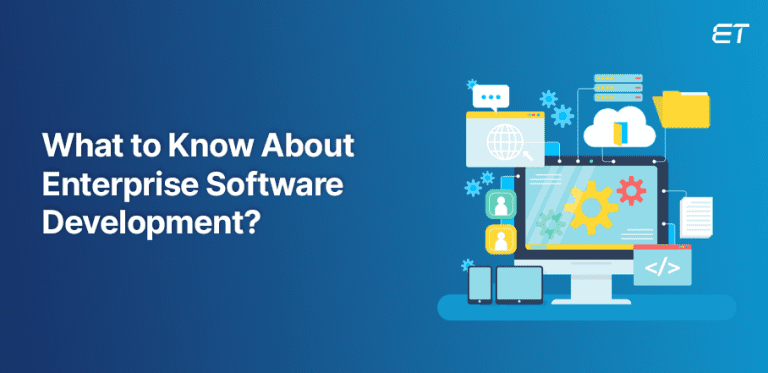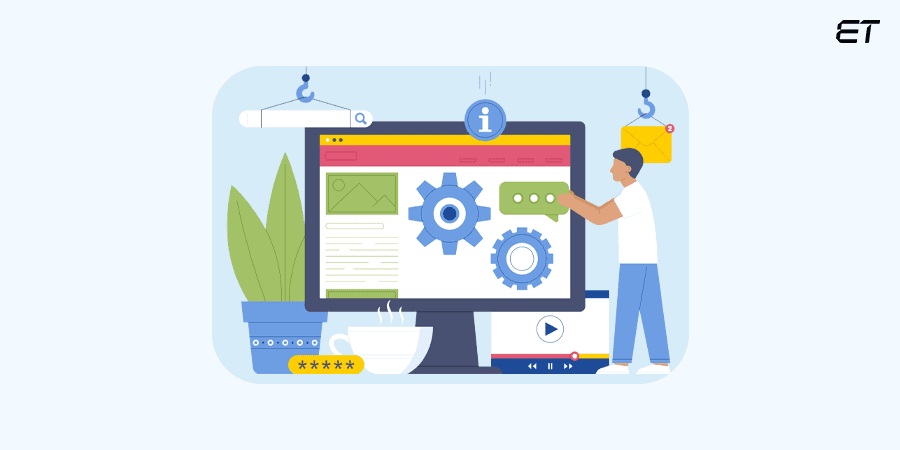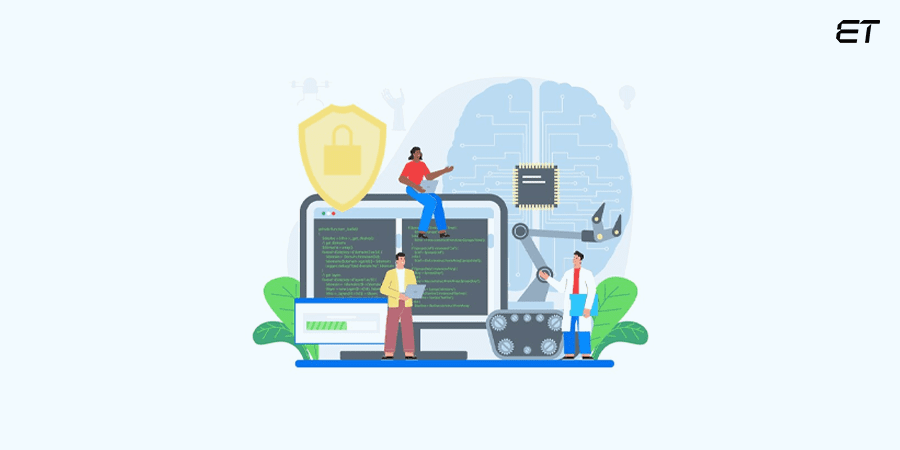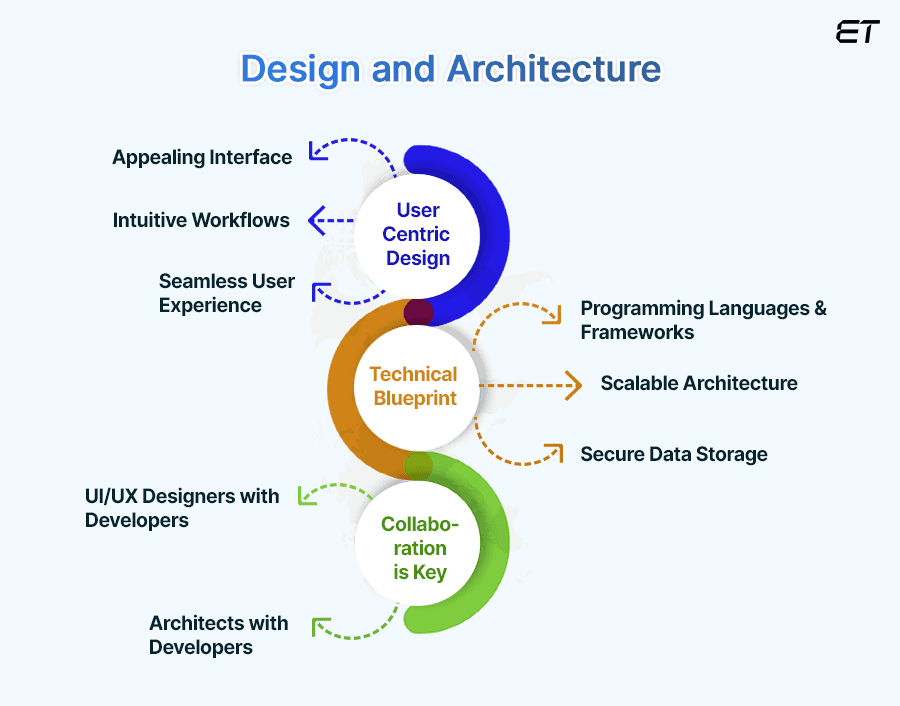
How IT Vendors Build Enterprise Software: A Complete Guide
Tesla, Amazon, FedEx, Netflix, and DBS Bank are prominent names in their respective domains. In fact, most of you would be glad to join the list of such well-known global organizations.
But why did we mention these names? Well, we want you to understand one common element between them. Yes, you guessed it. The common link between them is ‘enterprise software development.’
Successful organizations acquire such services to meet variable demands. That’s why enterprise software revenue hovers around USD 295 billion.
So, if you are a business, developing a tailormade enterprise software is the way to go. This blog explains all the crucial points to consider.
What is Enterprise Software Development?
Simply put, enterprise software development involves creating digital platforms that meet your company’s requirements.
Unlike generic software, a tailored product addresses your pain points, automates tedious tasks, and fosters improved efficiency across all departments.

The enterprise software development process offers several benefits to a business. Here are some of the main ones:
- Enhanced Efficiency
- Improved Decision-Making
- Increased Scalability
- Enhanced Security
- Competitive Advantage
Most of these advantages are self-explanatory. However, we will correlate them with the main facets of this development approach.

Need to know why global businesses are hiring Indian developers to build custom enterprise solutions?
How Enterprise Software Development Helps Businesses?
Let us delve right into the main technical reasons behind the high utility of enterprise software development.
Seamless Integration with Your Systems

A personalized enterprise software seamlessly integrates with existing systems like ERP, CRM, and others. This connectivity creates a unified data flow, reducing the dependency on manual data entry and ensuring that all departments have access to the latest information.
Through enterprise software development, you can automate tasks that currently require switching between multiple platforms. This eliminates redundancies and creates a smoother workflow for employees.
Furthermore, real-time data dashboards and reports provide insights into business processes, allowing for data-driven decision-making and improved performance.
Tailored Functionality of the Software

Off-the-shelf software often offers generic features that may not perfectly address your specific needs. However, developing an enterprise software from scratch allows you to build functionalities directly targeting your unique challenges and processes.
So, you do not need expensive software upgrades or rip-and-replace scenarios as your business scales.
Robust Security That Meets Your Demands

If you buy off-the-shelf enterprise software, the package includes pre-defined security features, which might not address your industry’s specific needs. However, enterprise software development allows you to implement robust security protocols tailored to your data and industry regulations.
In addition, generic software is a target for hackers, and vulnerabilities can leave your business data exposed. So, a tailored approach in software development allows you to address potential security risks from the initial phase.

Want to know why businesses choose IT staff augmentation in today’s era? Then, get IT staff augmentation benefits in our insightful blog.
Ability to Leverage Automation

Enterprise software development can help build a platform that automates repetitive tasks such as data entry, report generation, and approval workflows. This aspect frees up employee time for more strategic and human-centric activities and reduces the risk of errors.
Also, a unique software built for your organization can significantly improve the overall efficiency of your business processes by seamlessly automating tasks and streamlining workflows.
Systematic Process of Enterprise Software Development
Now, the benefits of developing your enterprise software are evident. So, you should know the process most authentic vendors follow to build such an ergonomic and value-oriented platform. This section explains each step in detail.
1. Project Discovery and Requirements Gathering
The success of any enterprise software development project depends on a solid foundation. That’s where project discovery and requirements gathering come into the picture.

During project discovery, a vendor delves deep into your organization’s current state. Through interviews, workshops, and surveys with key stakeholders across departments, the team identifies the following:
- Pain Points
- Current Processes
- Business Goals
Then, they move on to requirements gathering.
Once the enterprise software development vendor clearly understands your business needs, they focus on actionable requirements for the development team.
Here are the main pointers to consider:
- Functional Requirements: Define the specific functionalities the software should possess. This includes features, user stories (user interactions with the software), and desired outputs
- Prioritization: Rank functionalities based on importance and business impact. This aspect helps the development team focus on the most critical features first
- Non-Functional Requirements: These define the software’s overall characteristics
Overall, this phase helps determine how the stakeholders measure the software’s success. These facets could include increased sales, improved customer satisfaction, or reduced operational costs.

Want to go in-depth on the topic of project discovery phase? If the answer is yes, get details in our blog of Project Discovery Phase.
2. Feasibility Study and Planning
In this stage, you should evaluate if your desired functionalities are technically achievable with current technology and resources.

For this purpose, develop a realistic budget for the project, considering development costs, ongoing maintenance, and potential hardware upgrades. Also, create a timeline with clear milestones for each development stage.
As a business, you should understand the value of communication at this stage. Consider the following points:
- Stakeholder Alignment: Keep key stakeholders informed about the feasibility study’s findings and the development plan. This aspect ensures everyone is on the same page and potential roadblocks can be addressed proactively
- Development Team Collaboration: Clearly communicate project goals, requirements, and timelines with the development team. This approach promotes a collaborative culture where the team can effectively translate your vision into reality
So, your enterprise software development should begin with such a robust foundation. You can analyze your IT vendor’s RFP document to streamline things at this stage.
3. Enterprise Software Design and Architecture
Following the groundwork laid in the previous stages, it’s time to delve into the technical aspects of bringing your custom software to life.

You can divide the design and architecture stage into two sections.
User Interface and User Experience Design
This aspect focuses on the visual elements users interact with, such as screens, buttons, and menus. The goal is to create an engaging, visually appealing, and responsive interface.
In UX design, the focus is on the overall user experience. The main components include user workflows, accessibility, and user feedback integration.
Software Architecture
This phase defines the software’s technical blueprint, outlining how its various components will interact. The main decision in this stage is to select the programming languages, frameworks, and databases that will be used to develop the enterprise software. The choice should consider factors like scalability, security, and developer expertise.
Next, the system architecture defines the overall structure of the software, including the front end (user interface), back end (server-side logic), and data storage layer.
During design and architecture, close collaboration between various teams is essential:
- UI/UX Designers and Developers: Designers create mockups and prototypes, while developers ensure the designs can be translated into a functional user interface
- Architects and Developers: Architects define the technical blueprint, and developers translate it into the software’s codebase
All in all, a well-defined design and architecture phase paves the way for a user-friendly, scalable, and secure enterprise software solution. By carefully crafting the user experience and establishing a robust technical foundation, you ensure the enterprise software integrates seamlessly with your existing systems and supports your business growth.
4. Enterprise Software Development and Implementation
The development and implementation stage involves translating the blueprints into a functional software solution and integrating it into your organization’s daily operations.

Many tailored software projects adopt an Agile development approach. This software development methodology breaks down the development process into smaller, manageable sprints. Each sprint focuses on specific functionalities, allowing continuous feedback and adjustments to ensure the final digital product aligns with your vision.
Experienced developers write code based on the design and architecture specifications. The code undergoes rigorous testing throughout development to identify and fix bugs, ensuring functionality and performance.
Next, a version control system tracks changes made to the codebase.
Now, the implementation phase is interesting. It often follows the steps below:
- After deciding the launch of your enterprise software, you initiate the training session
- The training should cover core functionalities, workflows, and best practices for user adoption
- Implementing new software can impact workflows and user habits. So, a well-defined change management plan helps employees adapt to the new system and minimize disruptions during the transition.
Remember, a successful development and implementation phase delivers a custom enterprise software solution that empowers your business. By utilizing Agile methodologies, robust testing procedures, and a well-defined deployment strategy, you ensure a smooth transition and maximize user adoption.

Should you augment your staff or choose the conventional outsourcing model?
5. Deployment and Training
The culmination of meticulous planning and development efforts arrives with deployment and training. This stage involves seamlessly integrating your custom enterprise software into your organization’s daily operations and empowering your employees to leverage its full potential.

The deployment strategy pivots on your specific needs and infrastructure. Here’s a breakdown of common options:
- On-Premise Deployment: The enterprise software resides on your servers, offering complete control over data security but requiring investment in hardware and maintenance
- Cloud Deployment: The software is hosted by a cloud service provider, providing scalability, remote accessibility, and reduced maintenance burden
- Hybrid Deployment: This approach combines on-premise and cloud elements, offering a flexible solution that caters to specific needs, such as keeping sensitive data on-premise while leveraging the cloud for scalability
For training and user adoption, you can implement the following tips:
- Effective user training is paramount for successful software adoption
- Tailor training materials and delivery methods to cater to different learning styles and user roles
- Establish a system for ongoing support after deployment. This could include a dedicated helpdesk, knowledge base articles, or internal champions who can assist colleagues
Above all, ensure that the enterprise software is operational within your chosen deployment environment and seamlessly integrated with existing systems.
Your employees should also have the knowledge and skills to utilize the software effectively and maximize its benefits.

Want to develop a solid enterprise software for your business? Then, explore our services and connect with us today!
Summing Up
Enterprise software development empowers businesses to streamline operations, gain a competitive edge, and achieve their strategic goals. Companies can leverage tailored software solutions that perfectly align with their unique needs by carefully navigating the process from project discovery to deployment and training.
This investment fosters innovation, improves decision-making, and propels businesses toward long-term success. Remember, choosing the right development partner is crucial for a smooth and successful software development journey. So, contact us and develop your enterprise software efficiently and professionally!
Frequently Asked Questions
1. Are there cost-effective ways to approach enterprise software development?
Yes. You can start with a core set of functionalities that address your most pressing needs. An experienced development team can optimize your software design for cost efficiency while maintaining functionality.
2. How can we manage a software development project if our team lacks expertise?
You can partner with the right custom enterprise software development partner to bridge the technical knowledge gap. Look for a team that offers regular updates and explanations throughout the process, ensuring you understand the development stages.
3. How long does it take to develop and implement enterprise software?
The development timeline of enterprise software depends on the complexity of your software. So, you should always connect with an experienced IT vendor to speed up the development process.





